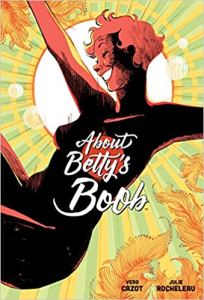Cruising Through The Louvre by David Prudhomme. Translation: Joe Johnson. NBM, 2016. 9781561639908.
 Prudhomme’s entry into NBM’s English editions of graphic novels about the Louvre is one of my favorites. It starts with him getting a phone call while staring at Rembrandt’s self portrait, and reflecting on wandering the museum, “It’s like walking inside a giant comic book. There are panels on every wall.” But what he really enjoys is looking at people looking at those panels, and that’s the focus of this book. Tourists peering at paintings while holding up phones, people experiencing private moments that seem almost religious, groups of students on a tour, and of course the mob admiring the Mona Lisa (and ignoring the large painting on the wall across from it) — this is an appreciation of people’s attention and whatever focus they can muster. (My favorite guy in the Mona Lisa mob is ignoring the painting entirely, reading a book.) Prudhomme’s pencils bring the people, the artwork, and the building itself to life in a way that reminds me of being in the museum. The woodwork alone is so intricate that it’s worth a visit by itself. (In fact when I was there years ago with my buddy Dave that’s all he looked at. The docents were very puzzled by his detailed questions about the floors.)
Prudhomme’s entry into NBM’s English editions of graphic novels about the Louvre is one of my favorites. It starts with him getting a phone call while staring at Rembrandt’s self portrait, and reflecting on wandering the museum, “It’s like walking inside a giant comic book. There are panels on every wall.” But what he really enjoys is looking at people looking at those panels, and that’s the focus of this book. Tourists peering at paintings while holding up phones, people experiencing private moments that seem almost religious, groups of students on a tour, and of course the mob admiring the Mona Lisa (and ignoring the large painting on the wall across from it) — this is an appreciation of people’s attention and whatever focus they can muster. (My favorite guy in the Mona Lisa mob is ignoring the painting entirely, reading a book.) Prudhomme’s pencils bring the people, the artwork, and the building itself to life in a way that reminds me of being in the museum. The woodwork alone is so intricate that it’s worth a visit by itself. (In fact when I was there years ago with my buddy Dave that’s all he looked at. The docents were very puzzled by his detailed questions about the floors.)

